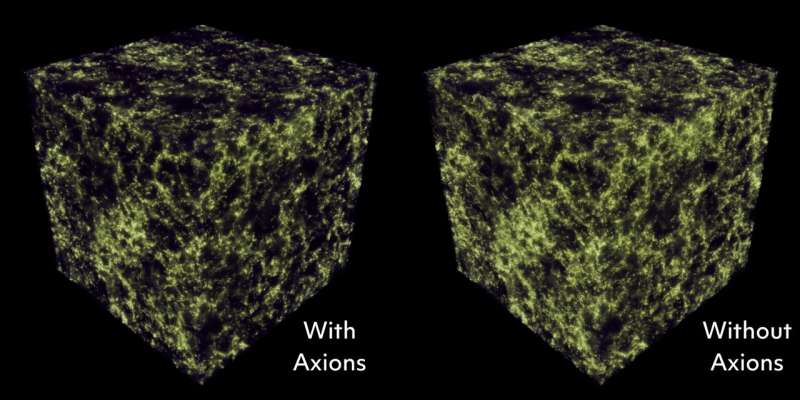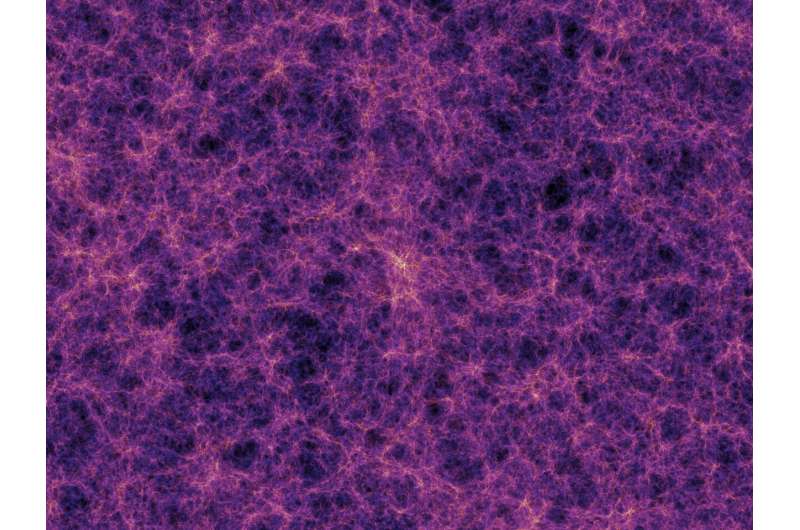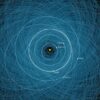In a study published today in the Journal of Cosmology and Astroparticle Physics, researchers at the University of Toronto reveal a theoretical breakthrough that may explain both the nature of invisible dark matter and the large-scale structure of the universe known as the cosmic web. The result establishes a new link between these two longstanding problems in astronomy, opening new possibilities for understanding the cosmos.
The research suggests that the “clumpiness problem,” which centers on the unexpectedly even distribution of matter on large scales throughout the cosmos, may be a sign that dark matter is composed of hypothetical, ultra-light particles called axions. The implications of proving the existence of hard-to-detect axions extend beyond understanding dark matter and could address fundamental questions about the nature of the universe itself.
“If confirmed with future telescope observations and lab experiments, finding axion dark matter would be one of the most significant discoveries of this century,” says lead author Keir Rogers, Dunlap Fellow at the Dunlap Institute for Astronomy & Astrophysics in the Faculty of Arts & Science at the University of Toronto.
“At the same time, our results suggest an explanation for why the universe is less clumpy than we thought, an observation that has become increasingly clear over the last decade or so, and currently leaves our theory of the universe uncertain.”
Dark matter, comprising 85 percent of the universe’s mass, is invisible because it does not interact with light. Scientists study its gravitational effects on visible matter to understand how it is distributed in the universe.
A leading theory proposes that dark matter is made of axions, described in quantum mechanics as “fuzzy” due to their wave-like behavior. Unlike discrete point-like particles, axions can have wavelengths larger than entire galaxies. This fuzziness influences the formation and distribution of dark matter, potentially explaining why the universe is less clumpy than predicted in a universe without axions.
This lack of clumpiness has been observed in large galaxy surveys, challenging the other prevailing theory that dark matter consists only of heavy, weakly interacting sub-atomic particles called WIMPs. Despite experiments like the Large Hadron Collider, no evidence supporting the existence of WIMPs has been found.
“In science, it’s when ideas break down that new discoveries are made and age-old problems are solved,” says Rogers.
For the study, the research team—led by Rogers and including members of associate professor Renée Hložek’s research group at the Dunlap Institute, as well as from the University of Pennsylvania, Institute for Advanced Study, Columbia University and King’s College London—analyzed observations of relic light from the Big Bang, known as the Cosmic Microwave Background (CMB), obtained from the Planck 2018, Atacama Cosmology Telescope and South Pole Telescope surveys.

A computer simulation of a section of the universe with and without axions showing how the dark matter cosmic web structure is less clumpy if containing axions. For scale, the Milky Way galaxy would sit inside one of the small green dots that are called halos. © Alexander Spencer London/Alex Laguë.
The researchers compared these CMB data with galaxy clustering data from the Baryon Oscillation Spectroscopic Survey (BOSS), which maps the positions of approximately a million galaxies in the nearby universe. By studying the distribution of galaxies, which mirrors the behavior of dark matter under gravitational forces, they measured fluctuations in the amount of matter throughout the universe and confirmed its reduced clumpiness compared to predictions.
The researchers then conducted computer simulations to predict the appearance of relic light and the distribution of galaxies in a universe with long dark matter waves. These calculations aligned with CMB data from the Big Bang and galaxy clustering data, supporting the notion that fuzzy axions could account for the clumpiness problem.
Future research will involve large-scale surveys to map millions of galaxies and provide precise measurements of clumpiness, including observations over the next decade with the Rubin Observatory.
The researchers hope to compare their theory to direct observations of dark matter through gravitational lensing, an effect where dark matter clumpiness is measured by how much it bends the light from distant galaxies, akin to a giant magnifying glass. They also plan to investigate how galaxies expel gas into space and how this affects the dark matter distribution to further confirm their results.

In shaping the universe, gravity builds a vast cobweb-like structure of filaments tying galaxies and clusters of galaxies together along invisible bridges hundreds of millions of light-years long. This is known as the cosmic web. © Volker Springel (Max Planck Institute for Astrophysics) et al.
Understanding the nature of dark matter is one of the most pressing fundamental questions and key to understanding the origin and future of the universe.
Presently, scientists do not have a single theory that simultaneously explains gravity and quantum mechanics—a theory of everything. The most popular theory of everything over the last few decades is string theory, which posits another level below the quantum level, where everything is made of string-like excitations of energy. According to Rogers, detecting a fuzzy axion particle could be a hint that the string theory of everything is correct.
“We have the tools now that could enable us to finally understand something experimentally about the century-old mystery of dark matter, even in the next decade or so—and that could give us hints to answers about even bigger theoretical questions,” says Rogers. “The hope is that the puzzling elements of the universe are solvable.”
More information:
Ultra-light axions and the S8 tension: joint constraints from the cosmic microwave background and galaxy clustering, Journal of Cosmology and Astroparticle Physics (2023). DOI: 10.1088/1475-7516. iopscience.iop.org/article/10. … 475-7516/2023/06/023
Provided by
University of Toronto
Citation:
Astronomers discover new link between dark matter and clumpiness of the universe (2023, June 14)



